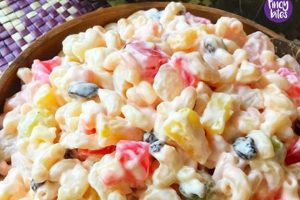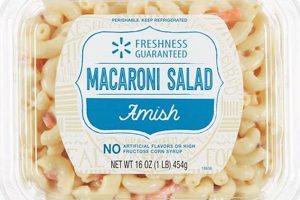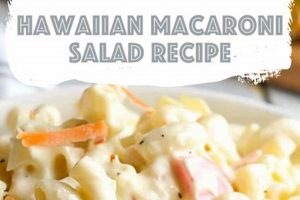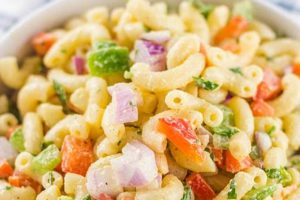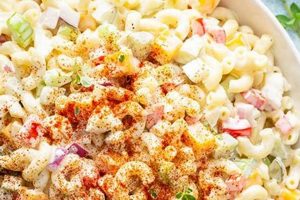This dish represents a localized adaptation of a classic Western pasta salad, typically featuring elbow macaroni, vegetables, and a creamy, mayonnaise-based dressing. Common additions include shredded chicken, hot dogs, ham, cheese, and sweet pickle relish, creating a unique flavor profile that balances savory, sweet, and tangy elements. Variations may incorporate raisins, pineapple chunks, or other fruits for added sweetness.
The dish holds a prominent place in Filipino cuisine, often served during festive occasions, holidays, and everyday meals. Its popularity stems from its affordability, ease of preparation, and adaptability to various ingredients based on regional preferences and seasonal availability. The fusion of Western influences with local Filipino tastes highlights the country’s rich culinary history and cultural exchange. This adaptation showcases a creative blending of flavors, transforming a simple pasta salad into a distinctly Filipino dish. Its enduring presence on Filipino tables signifies its cultural importance and widespread appeal.
Further exploration will delve into specific ingredient combinations, regional variations, preparation methods, and serving suggestions for this beloved Filipino dish.
Tips for Preparing Macaroni Salad
Achieving optimal flavor and texture requires attention to specific details throughout the preparation process. These tips offer guidance for creating a successful and satisfying dish.
Tip 1: Cook the pasta al dente. Slightly firm pasta holds its shape better and prevents a mushy texture in the final salad. Overcooked pasta absorbs too much dressing, leading to an unbalanced dish.
Tip 2: Chill the pasta thoroughly. Cooling the cooked pasta before adding other ingredients prevents the mayonnaise-based dressing from separating and ensures a more cohesive salad.
Tip 3: Use high-quality mayonnaise. The dressing forms the base of the flavor profile, so selecting a good quality mayonnaise significantly impacts the overall taste.
Tip 4: Balance sweetness and tanginess. Adjust the levels of sugar, sweet pickle relish, and other sweet or acidic ingredients to achieve the desired flavor balance. Taste and adjust as needed.
Tip 5: Incorporate a variety of textures. A combination of crunchy vegetables, smooth mayonnaise, and chewy pasta creates a more interesting and enjoyable sensory experience. Consider adding chopped celery, carrots, or bell peppers for added crunch.
Tip 6: Chill the salad before serving. Allowing the flavors to meld in the refrigerator for at least an hour enhances the overall taste and provides a refreshing element.
Tip 7: Garnish thoughtfully. A simple garnish, such as chopped chives, parsley, or a sprinkle of paprika, elevates the presentation and adds a final touch of flavor.
By following these tips, one can achieve a well-balanced, flavorful, and visually appealing dish. Attention to these details ensures a successful culinary experience.
These preparation tips provide a solid foundation for creating a delicious and authentic version of this popular dish. The following section will offer variations and serving suggestions.
1. Elbow Macaroni
Elbow macaroni forms the foundational ingredient in Filipino macaroni salad, contributing significantly to its texture and overall character. The curved shape of the pasta effectively holds the creamy dressing, ensuring each piece is well-coated and contributes to the rich, cohesive mouthfeel. Its small size allows for easy incorporation with other ingredients, creating a harmonious blend of flavors and textures. Substituting other pasta shapes alters the dish’s classic presentation and can negatively impact the dressing’s adherence, ultimately affecting the overall sensory experience. For instance, using long, thin pasta like spaghetti results in a less cohesive salad, with the dressing sliding off the strands rather than coating them evenly. The choice of elbow macaroni is thus integral to the dish’s authentic identity and optimal enjoyment.
The prevalence of elbow macaroni in Filipino macaroni salad likely stems from its widespread availability and affordability, alongside its suitability for absorbing flavors and holding the mayonnaise-based dressing. This practicality makes it an ideal choice for large gatherings and celebrations, where this dish is a staple. Furthermore, the shape’s ability to capture small pieces of vegetables and other ingredients within its curves enhances the eating experience, delivering a balanced combination of flavors in each bite. This practicality, combined with its textural contribution, solidifies elbow macaroni’s crucial role in this beloved Filipino dish.
In conclusion, elbow macaroni’s importance in Filipino macaroni salad extends beyond mere convenience. Its unique shape plays a crucial role in the dish’s texture, flavor distribution, and overall appeal. Understanding this connection emphasizes the thoughtful consideration behind seemingly simple ingredient choices in creating a truly authentic and enjoyable culinary experience.
2. Creamy Dressing
Creamy dressing constitutes a defining characteristic of Filipino macaroni salad, distinguishing it from other pasta salad variations. This dressing, typically mayonnaise-based, contributes significantly to the dish’s texture, flavor, and overall appeal. The emulsion provides a rich, smooth mouthfeel that coats the pasta and other ingredients, creating a cohesive and satisfying culinary experience. Beyond texture, the dressing also acts as a flavor vehicle, carrying the tangy notes of vinegar or calamansi, the sweetness of sugar, and the savory depth of optional additions like mustard or condensed milk. This interplay of flavors within the creamy base creates a balanced profile that characterizes the dish.
The choice and preparation of the creamy dressing often reflect regional and personal preferences. While mayonnaise serves as the primary base, variations exist. Some recipes incorporate condensed milk for added sweetness and richness, while others utilize all-purpose cream or a combination of mayonnaise and cream. The addition of calamansi juice, a common Filipino citrus fruit, introduces a bright, tangy note that balances the richness of the mayonnaise. These variations underscore the adaptability of the dish and the potential for personalized interpretations within a shared culinary tradition. For example, regions with greater access to fresh calamansi might favor its inclusion, while others might opt for vinegar or other acidic components. These nuanced choices contribute to the diversity of Filipino macaroni salad experiences across the archipelago.
Understanding the role of creamy dressing in Filipino macaroni salad is crucial for appreciating the dish’s complexity and cultural significance. It goes beyond simply binding the ingredients; it acts as a canvas for flavor development and a reflection of individual and regional preferences. Mastering the balance of richness, tanginess, and sweetness within the dressing is key to achieving an authentic and enjoyable representation of this beloved Filipino dish. This knowledge allows for a deeper appreciation of the culinary artistry involved in creating a seemingly simple, yet culturally significant, dish.
3. Sweet Relish
Sweet relish constitutes a crucial element in Filipino macaroni salad, contributing a distinctive sweet and tangy flavor profile that sets it apart from other variations. Its presence elevates the dish beyond a simple combination of pasta and mayonnaise, adding depth and complexity. Understanding the role of sweet relish requires exploring its various facets, from its composition and preparation to its cultural significance and impact on the overall sensory experience.
- Flavor Profile
Sweet relish provides a balanced contrast to the richness of the mayonnaise and the savory elements often present in Filipino macaroni salad, such as chicken or hot dogs. The combination of sweetness, tanginess, and subtle spices creates a dynamic interplay of flavors that enhances the overall palatability. The specific flavor profile can vary depending on the brand or homemade recipe used, with some emphasizing sweetness while others highlight a more pronounced tang. This variation allows for customization and contributes to the diversity of Filipino macaroni salad preparations.
- Texture and Visual Appeal
Sweet relish contributes to the textural complexity of the salad, adding small, crunchy pieces that contrast with the softness of the pasta and the creaminess of the dressing. Visually, the colorful flecks of relish dispersed throughout the salad enhance its aesthetic appeal, making it more inviting. This visual element contributes to the overall enjoyment of the dish, particularly during festive occasions where presentation plays a significant role.
- Cultural Significance
The incorporation of sweet relish reflects the fusion of Western influences and local Filipino tastes. While macaroni salad is not indigenous to the Philippines, its adaptation and inclusion of ingredients like sweet relish demonstrate the country’s history of cultural exchange and culinary creativity. The widespread use of sweet relish in Filipino macaroni salad has solidified its place as a key ingredient, contributing to the dish’s unique identity and cultural significance. This adaptation distinguishes Filipino macaroni salad from its Western counterparts, highlighting the evolution of the dish within a specific cultural context.
- Availability and Accessibility
Commercially produced sweet relish is readily available in the Philippines, making it a convenient and accessible ingredient for home cooks. This widespread availability further contributes to the popularity and ubiquity of Filipino macaroni salad across the archipelago. The ease of incorporating pre-made sweet relish simplifies the preparation process, making the dish even more appealing for everyday meals and larger gatherings.
In summary, sweet relish plays a multifaceted role in Filipino macaroni salad, influencing its flavor, texture, visual appeal, and cultural significance. Its presence elevates the dish beyond a simple pasta salad, transforming it into a distinctly Filipino culinary experience. The interplay of sweet, tangy, and crunchy elements, combined with the ingredient’s accessibility and cultural relevance, solidifies sweet relish as an essential component of this beloved dish.
4. Local Vegetables
Local vegetables play a crucial role in Filipino macaroni salad, contributing not only to its nutritional value but also its distinct flavor, texture, and cultural relevance. The selection of vegetables often reflects regional preferences and seasonal availability, showcasing the adaptability and resourcefulness inherent in Filipino cuisine. This practice of incorporating locally sourced produce strengthens community ties, supports local farmers, and reduces environmental impact associated with long-distance transportation.
Commonly used vegetables include carrots, potatoes, and green peas. Carrots provide a subtle sweetness and a satisfying crunch, while potatoes offer a creamy texture that complements the richness of the mayonnaise-based dressing. Green peas contribute a burst of freshness and a pop of color. Beyond these staples, regional variations may incorporate other vegetables like sayote (chayote), corn, or green beans, reflecting the diversity of agricultural produce across the Philippine archipelago. For example, in areas where sayote is abundant, it adds a mild, refreshing flavor and a unique texture to the salad. The use of readily available ingredients ensures affordability and accessibility, making Filipino macaroni salad a dish enjoyed by people from all socioeconomic backgrounds. This adaptability also minimizes food waste, as surplus produce can be readily incorporated into the salad.
The inclusion of local vegetables underscores the connection between Filipino macaroni salad and the local agricultural landscape. This emphasis on fresh, seasonal produce enhances the nutritional value of the dish, providing essential vitamins, minerals, and dietary fiber. Furthermore, it fosters a sense of community and culinary identity, highlighting the importance of local ingredients in shaping Filipino cuisine. This understanding not only enriches the culinary experience but also promotes sustainable food practices and strengthens local economies. The ability to adapt the recipe based on available produce also reflects the resilience and resourcefulness of Filipino culinary traditions, making it a dish that is both culturally significant and practically adaptable.
5. Protein Additions
Protein additions represent a significant aspect of Filipino macaroni salad, contributing to its nutritional value, textural complexity, and overall flavor profile. While not strictly essential, these additions enhance the dish’s heartiness and transform it from a side dish to a more substantial meal. Examining the types of protein commonly used, their cultural relevance, and impact on the overall culinary experience provides a deeper understanding of Filipino macaroni salad.
- Common Choices
Chicken, often shredded or diced, stands as a popular protein choice, adding a mild savory flavor and tender texture. Hot dogs, sliced into rounds, offer a distinct salty and slightly smoky note, contributing a familiar and well-liked element. Other options include ham, often diced, which provides a more pronounced salty and savory flavor, and luncheon meat, a processed meat product that adds a unique texture and flavor profile. The choice of protein often reflects personal preference and availability, showcasing the adaptability of the dish.
- Cultural Influences
The incorporation of processed meats like hot dogs and luncheon meat reflects the influence of American cuisine on Filipino food culture, particularly during the post-World War II era. These ingredients became readily available and affordable, integrating themselves into local culinary traditions. The use of chicken, a more traditional protein source in Filipino cuisine, represents a balance between familiar flavors and adopted influences, showcasing the dynamic nature of Filipino foodways.
- Textural Impact
Protein additions contribute to the textural diversity of Filipino macaroni salad. The tender strands of chicken, the firm bite of hot dogs, or the smooth texture of luncheon meat contrast with the softness of the pasta and the creaminess of the dressing, creating a more engaging and satisfying mouthfeel. This interplay of textures elevates the sensory experience of the dish, adding another layer of complexity.
- Nutritional Considerations
Incorporating protein elevates the nutritional value of Filipino macaroni salad, providing essential amino acids necessary for bodily functions. The specific nutritional contribution varies depending on the protein source chosen. Lean chicken breast, for example, offers a healthier option compared to processed meats which tend to be higher in sodium and saturated fat. These nutritional considerations play a role in individual dietary choices and preferences.
In conclusion, protein additions in Filipino macaroni salad play a multifaceted role, impacting the dish’s nutritional content, flavor profile, textural complexity, and cultural significance. Understanding the interplay of these factors provides a deeper appreciation for the dish’s evolution and its continued popularity in Filipino cuisine. The adaptability of protein choices reflects the dynamic and evolving nature of Filipino food culture, demonstrating its ability to incorporate and adapt external influences while retaining its unique identity. This adaptability also makes the dish accessible to a wide range of preferences and dietary needs, further solidifying its place as a staple in Filipino culinary traditions.
6. Festive Occasions
Filipino macaroni salad occupies a prominent place in celebratory meals and festive gatherings, signifying its cultural importance within the Philippines. Examining its connection to these occasions reveals insights into Filipino traditions, values, and the dish’s evolution within a specific cultural context. Its presence on celebratory tables signifies more than just a culinary choice; it represents a shared cultural experience and a symbol of festivity.
- Symbol of Abundance and Prosperity
Macaroni salad, often prepared in large quantities, symbolizes abundance and prosperity. Its presence during festive occasions reflects a desire for good fortune and a celebratory spirit of generosity. The sharing of this dish reinforces communal bonds and strengthens social connections. This symbolism connects to broader Filipino cultural values of hospitality and sharing, particularly during times of celebration. For instance, during Christmas and New Year celebrations, overflowing platters of macaroni salad signify a bountiful and prosperous year ahead.
- Ease of Preparation and Sharing
The relative ease of preparing macaroni salad, especially in larger quantities, makes it a practical choice for festive gatherings. Its make-ahead nature allows hosts to focus on other aspects of the celebration. Furthermore, the dish’s communal serving style, typically in large bowls, encourages sharing and interaction among guests. This practicality contributes to the dish’s popularity, particularly during events involving numerous attendees, such as weddings, birthdays, and fiestas. This practicality frees up time and resources, allowing for greater focus on the social aspects of the celebration.
- Adaptability and Regional Variations
The adaptable nature of Filipino macaroni salad allows for regional and personal variations, accommodating diverse tastes and preferences. Different regions may incorporate unique ingredients, reflecting local specialties and culinary traditions. This adaptability ensures the dish remains relevant and appealing across different communities and generations, strengthening its cultural significance. For example, some regions might add more fruit, while others might prefer a more savory version with additional protein. This flexibility allows the dish to be personalized and tailored to specific tastes, further solidifying its place within the celebratory meal.
- Intergenerational Connection and Nostalgia
Macaroni salad often evokes a sense of nostalgia, connecting generations through shared culinary experiences. Its presence at family gatherings and traditional celebrations creates a sense of continuity and reinforces cultural identity. For many Filipinos, the taste of macaroni salad evokes memories of past celebrations, family gatherings, and childhood experiences. This intergenerational connection contributes to the dish’s enduring popularity and its significance within Filipino culture. This nostalgic association strengthens family bonds and transmits cultural traditions across generations, ensuring the continued presence of Filipino macaroni salad in future celebrations.
The connection between Filipino macaroni salad and festive occasions reveals a deeper understanding of Filipino culture, values, and culinary traditions. The dish’s symbolism of abundance, its practicality, adaptability, and nostalgic associations contribute to its enduring popularity and its integral role in celebratory meals. This exploration highlights the significance of food in shaping cultural identity and strengthening communal bonds, demonstrating how a seemingly simple dish can embody complex cultural meanings and traditions. The continued presence of Filipino macaroni salad in festive occasions underscores its importance as a cultural touchstone and a symbol of shared heritage.
Frequently Asked Questions
This section addresses common inquiries regarding the preparation and variations of Filipino macaroni salad.
Question 1: What type of mayonnaise is best suited for Filipino macaroni salad?
While any good quality mayonnaise works, using a brand commonly found in the Philippines can contribute to a more authentic flavor profile. Experimentation with different brands allows for personalized taste preferences.
Question 2: Can other pasta shapes be substituted for elbow macaroni?
While other short pasta shapes can be used, elbow macaroni is traditional and its curved shape holds the dressing effectively. Substituting other shapes may alter the dish’s classic texture and presentation.
Question 3: How long can Filipino macaroni salad be stored in the refrigerator?
Properly stored in an airtight container, it typically lasts for 3-5 days in the refrigerator. However, it’s crucial to monitor for any signs of spoilage before consumption.
Question 4: Can the sweetness level be adjusted?
The sweetness can be adjusted by increasing or decreasing the amount of sugar or condensed milk added to the dressing. Tasting and adjusting throughout the preparation process is recommended.
Question 5: What are some common variations of Filipino macaroni salad?
Variations often incorporate different protein additions, such as shredded chicken, ham, or luncheon meat. Regional variations may also include local vegetables or fruits like pineapple or raisins.
Question 6: Can Filipino macaroni salad be served warm?
It is traditionally served chilled. Serving it warm may compromise the texture and stability of the mayonnaise-based dressing.
Understanding these common inquiries allows for a more informed approach to preparing and enjoying Filipino macaroni salad. Careful consideration of these points enhances the overall culinary experience.
The following section will offer a selection of authentic Filipino macaroni salad recipes.
Macaroni Salad Philippines Recipe
Exploration of the “macaroni salad Philippines recipe” reveals a dish deeply embedded in Filipino culture. From its core componentselbow macaroni, creamy dressing, sweet relish, local vegetables, and protein additionsto its prominence in festive occasions, this dish embodies adaptability, resourcefulness, and a fusion of local and international influences. Analysis of ingredient choices, preparation methods, and cultural context underscores the dish’s significance beyond mere sustenance. It functions as a symbol of abundance, a testament to culinary creativity, and a vehicle for intergenerational connection.
Macaroni salad’s enduring presence in Filipino cuisine signifies its ongoing relevance. Continued exploration of regional variations and evolving culinary practices promises further insights into this dish’s dynamic nature. Its adaptability ensures its continued presence at Filipino tables, signifying a vibrant culinary tradition passed down through generations. This exploration serves not just as a recipe analysis but as a window into the rich tapestry of Filipino food culture.

